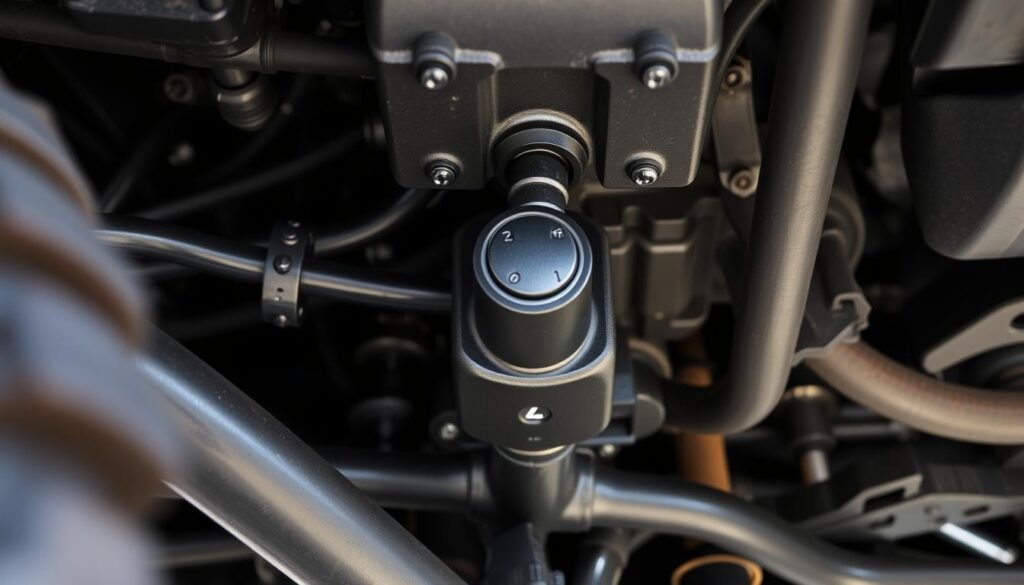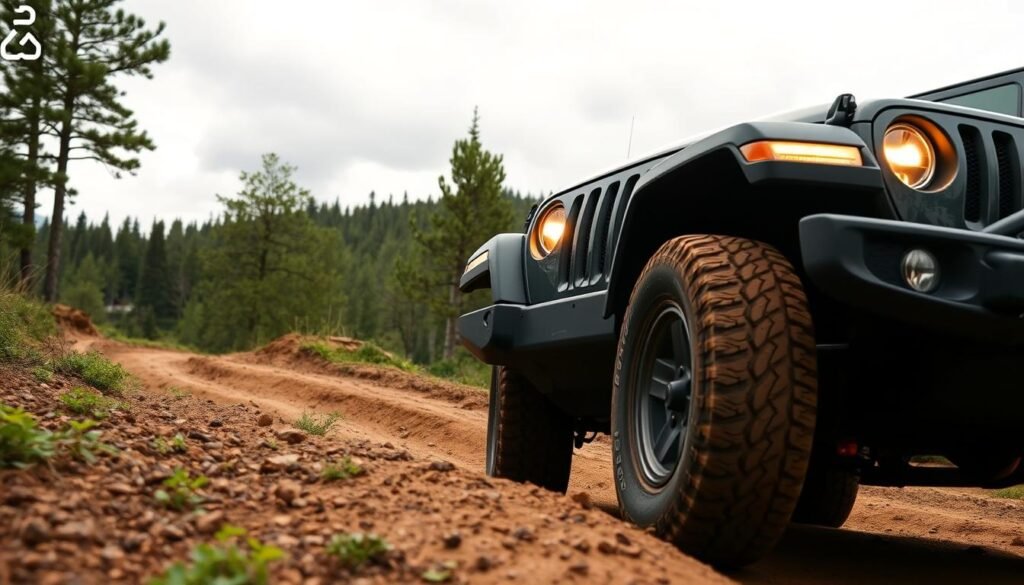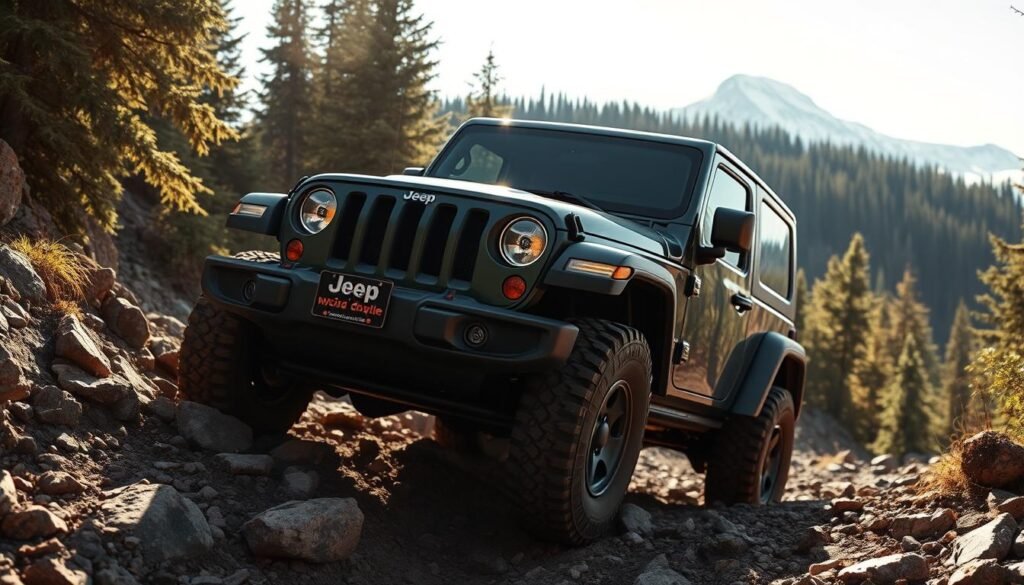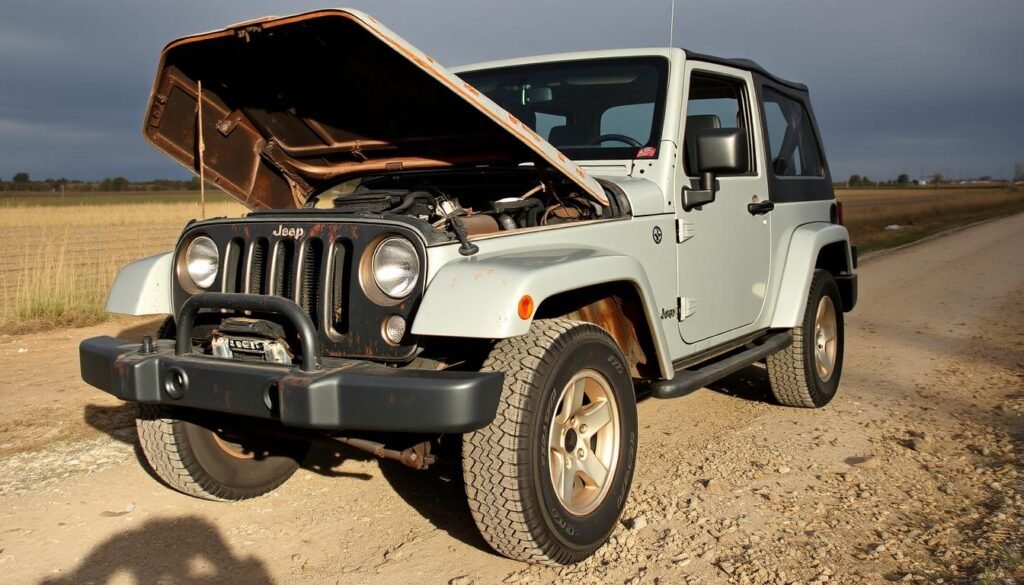“The key to adventure is not just having a capable vehicle, but understanding how to unlock its full potentia.” – Jeep Trail Masters
Driving a Jeep means embracing versatility, but most owners never explore their vehicle’s true capabilities. Surprisingly, 70-90% of Jeep owners rarely venture off paved roads. They miss out on the remarkable 4-wheel drive performance.
Learning how to put your Jeep in 4 wheel drive isn’t just about technical knowledge. It’s about expanding your driving experience. Whether you’re navigating challenging terrain or facing unpredictable weather conditions, understanding how to put Jeep in 4 wheel drive can transform your driving confidence.
This guide will walk you through the essential steps of engaging your Jeep’s 4-wheel drive system. We’ll explain the nuances of different drive modes. And ensure you can handle various driving environments with expertise.
Understanding Your Jeep’s 4-Wheel Drive System
Exploring Jeep 4WD systems shows a complex yet interesting technology. It’s made to improve vehicle performance on various terrains. The Jeep 4WD system gives drivers control and traction in tough driving situations.
Types of 4WD Systems in Jeeps
Jeep has several 4-wheel drive systems for different needs:
- Command-Trac®: Offers a 50/50 torque split between front and rear axles
- Quadra-Drive II®: Can send up to 100% of torque to one wheel
- Active Drive Lock: Has a mechanical rear axle lock
- Rock-Trac®: Made for slippery and loose surfaces
Components of the Transfer Case
The transfer case is key in any Jeep 4WD system. It sends power to the front and rear axles. This lets drivers easily switch between drive modes.
Drive Modes Explained
Jeep 4WD systems have three main drive modes:
- 2H (2-High): For normal road driving
- 4H (4-High): Offers extra traction at speeds under 50 mph
- 4L (4-Low): Boosts traction for tough off-road conditions, best at speeds under 15 mph
To use your Jeep’s 4-wheel drive, you need to know about these systems. Each mode is designed for a specific driving scenario. This ensures the best performance in different situations.
Locating the Transfer Case Shifter in Your Jeep

To start using your Jeep’s 4 wheel drive, first find the transfer case shifter. It’s usually on the left side of your main gear shift. This makes it simple to reach while driving.
The transfer case shifter lets you switch between drive modes. It has clear labels to show which mode you’re in:
- 2H: Standard two-wheel drive mode
- 4H: Four-wheel drive high-range mode
- N: Neutral position
- 4L: Four-wheel drive low-range mode
Jeeps like the Wrangler 4XE use the Command Trac 4×4 System. This system makes it easy to switch drive modes based on where you’re driving.
Look closely at your transfer case shifter. Its labels show different driving settings. Each setting is designed to help your Jeep perform best in different places.
Pro Tip: Get to know the transfer case shifter’s spot and labels before tackling tough driving spots.
The design and spot of the transfer case shifter make it easy for anyone to use their Jeep’s 4 wheel drive.
How To Put Jeep In 4 Wheel Drive
Putting your Jeep in 4-wheel drive needs focus and knowing how to shift. Learning the right way helps your Jeep perform better and keeps it safe from damage.
Basic Safety Precautions
Before you start, remember these important safety tips:
- Always stop completely before shifting
- Make sure you’re on a solid surface
- Check your manual for exact steps
- Don’t shift while turning or on steep hills
Speed Requirements for Shifting
Each 4WD mode has its own speed limit for safe use:
| Drive Mode | Recommended Speed | Best Used For |
|---|---|---|
| 4H (Four-Wheel Drive High) | Under 40 mph | Slippery conditions, light off-road terrain |
| 4L (Four-Wheel Drive Low) | 2-3 mph | Extreme off-road conditions, maximum torque |
Proper Shifting Technique
Here’s how to shift into 4-wheel drive correctly:
- Slow down to the right speed
- Take your foot off the gas while shifting
- Move the transfer case shifter smoothly
- Wait for the dashboard to confirm
Pro tip: Always switch back to 2-wheel drive on regular roads to avoid wear on your drivetrain.
Shifting from 2H to 4H While Stationary

Knowing how to put your Jeep in 4 wheel drive is key. It’s important to understand your vehicle’s transfer case. The steps are simple if you know what to do.
First, make sure your Jeep is stopped and in park. The transfer case shifter is near the transmission or on the center console. Your Jeep must be in neutral with the parking brake on.
- Bring the vehicle to a complete stop
- Place the transmission in neutral
- Engage the parking brake
- Locate the 4WD transfer case shifter
When you shift to 4H, move the shifter smoothly. Listen for a clicking sound that means four-wheel drive is on. Some Jeeps have electronic systems that make shifting easier.
Always check your Jeep’s manual for the right steps. Different models might have different ways to engage 4WD.
Switching to 4H While Moving
Switching to 4H while driving needs precision and knowing how your Jeep’s transfer case works. Jeep enthusiasts say it’s important to pay close attention to speed and technique when changing drive modes.

Speed Limitations for 4H Engagement
When you’re learning to put your Jeep in 4 wheel drive while moving, speed is key. Here’s the speed range you should aim for when shifting to 4H:
- Keep speeds under 45 miles per hour
- The best time to switch is between 15-35 mph
- Try to avoid high-speed shifts to avoid damage
Proper Shifting Sequence
Shifting to 4H while driving needs a smooth, planned approach. Here’s how to do it right:
- Slow down to under 45 mph
- Momentarily release the accelerator
- Move the transfer case shifter to 4H
- Slowly press the gas again
When you successfully switch to 4H, a dashboard light will turn on. This shows the drive mode has changed. Jeep experts suggest practicing this in a safe place to get better at it.
Engaging 4-Wheel Drive Low (4L)
When you face tough terrain, knowing how to use your Jeep’s 4 wheel drive low (4L) is key. The 4L mode gives you the most torque and control for extreme driving.
Engaging 4L needs precision and careful steps. Your Jeep must be moving slowly, about 2-3 miles per hour. Here’s how to do it right:
- Reduce vehicle speed to 2-3 mph
- Shift transmission to neutral
- Activate the transfer case shifter to 4L position
- Wait for dashboard confirmation of 4WD engagement
It’s important to know the speed limit for 4L. Drivers should never go over 15 miles per hour in this mode. This helps avoid damage to the transfer case.
| 4L Mode Characteristics | Recommended Specifications |
|---|---|
| Maximum Speed | 15 mph |
| Ideal Terrain | Extreme off-road conditions |
| Torque Multiplication | Highest available |
Remember, 4L is for tough terrains like rocky trails, deep mud, or steep hills. Don’t use 4L on regular roads to avoid wear on your Jeep’s drivetrain.
Pro tip: Always check your Jeep’s owner manual for specific instructions on using 4-wheel drive low.
Common Mistakes to Avoid When Shifting
Driving your Jeep in 4-wheel drive needs care and precision. Knowing how to switch to 4 wheel drive right can avoid expensive mistakes. These mistakes could harm your vehicle’s drivetrain.
Drivers often make mistakes that hurt their Jeep’s performance and life. Wrong shifting can cause big mechanical problems:
- Up to 30% increased drivetrain wear from frequent mode switching
- Potential repair costs exceeding $1,500 for transfer case damage
- 25% higher risk of axle and differential stress
Improper Speed During Shifts
Speed matters when changing drive modes. Shifting at the wrong speeds can cause temporary loss of traction. Studies show this happens in up to 40% of off-road incidents. Always follow the manufacturer’s guidelines for safe shifting speeds.
Shifting Under Heavy Load
Trying to change drive modes when your vehicle is heavily loaded can cause mechanical stress. Mental fatigue during mode management increases error risks by 50%. This can lead to incorrect engagement during critical driving moments.
Pro Tip: Always ensure your Jeep is in the optimal condition before switching drive modes to prevent unnecessary wear and possible damage.
By knowing these common 4WD shifting mistakes, you can keep your Jeep running well and last longer.
Returning to 2-Wheel Drive
Knowing how to switch your Jeep to 4 wheel drive is key. But, it’s just as important to know how to switch back to 2WD. This requires careful attention to speed and the driving conditions.
When you need to switch back to 2-wheel drive, you have several options. These depend on your Jeep model and the situation you’re in. You can usually disengage 4-wheel drive in two main ways:
- While driving at speeds up to 40 MPH
- When the vehicle is completely stopped
To shift back to 2WD from 4H (4-High), follow these steps:
- Slow down to 40 MPH or less
- Find the transfer case shifter
- Move the shifter back to 2H smoothly
- Check the dashboard to see if it shows 2WD mode
If you’re in 4L (4-Low) mode, you must first shift to 4H. Always make sure you’re on a stable, flat surface when shifting.
Pro tip: Never force the transfer case shifter. If you meet resistance, stop and check your Jeep’s manual.
Jeep models can vary in their shifting mechanisms. Always check your specific vehicle’s owner manual. It will give you the exact steps for switching to 4 wheel drive and back to 2WD.
Maintenance Tips for 4WD System
To keep your Jeep’s 4-wheel drive system in great shape, you need to do regular 4WD system maintenance. This care helps your vehicle run at its best and lasts longer. It’s important for the parts that keep your Jeep moving.
Looking after your How To Put Jeep In 4 Wheel Drive system means checking a few important things. These checks can stop expensive fixes and keep your Jeep performing well.
Critical Inspection Checklist
- Check differential fluid every 25,000 to 50,000 kilometers
- Inspect transfer case for leaks or unusual wear
- Rotate tires every 7,500 kilometers to ensure even wear
- Examine wheel bearings, ball joints, and shock absorbers
- Clean chassis components after off-road driving
Lubrication Requirements
Lubrication is key to keeping your 4WD system healthy. Important lubrication spots include:
- Apply dielectric grease to electrical connectors annually
- Lubricate self-leveling system linkages
- Use white lithium grease on brake lines to prevent rust
- Ensure proper fluid levels in front and rear differentials
By sticking to these maintenance tips, your Jeep’s 4-wheel drive system will stay in top shape. It will be ready for any road or off-road adventure.
When to Use Different 4WD Modes
To use your Jeep’s 4 wheel drive, you need to know which mode is best for different situations. The right mode depends on the terrain and challenges you face.
Each 4WD mode has its own benefits for different driving needs:
- 2H (Two-Wheel High): Great for driving on highways and dry roads
- Reduces mechanical wear
- Improves fuel efficiency
- 4H (Four-Wheel High): Best for tough road conditions
- Works well on rainy, icy, or rocky roads
- Enhances traction
- Speed should not exceed 55 mph
- 4L (Four-Wheel Low): Ideal for extreme terrains
- Best for slow, high-torque situations
- Perfect for rock crawling
- Great for steep inclines and tough obstacles
Choosing the right 4WD mode depends on the terrain and driving conditions. Auto 4WD modes are good for mild dirt roads, job sites, and heavy rain. But, avoid using 4WD on dry pavement to prevent wear on the drivetrain.
Pro Tip: Always switch back to rear-wheel drive when road conditions improve to minimize mechanical wear.
Troubleshooting 4WD Engagement Issues
Jeep owners often face frustration with 4WD problems. If your 4-wheel drive system isn’t working right, there could be several reasons. A professional can diagnose the issue for 70-100 USD, finding out what’s wrong fast.
Modern Jeeps, like the Cherokee, use a lot of electronics for 4WD. Faulty 4WD actuators are common, showing up as dashboard lights. These parts can wear out from off-roading, costing about 100 USD to replace. Driveshafts and low transmission fluid also affect 4WD performance.
In places like Colorado, about 40% of Jeep owners deal with 4WD issues each year. The transfer case is key for 4WD to work. Regular maintenance can save up to 30% on repairs, which cost between 500 to 2,000 USD. To fix 4WD problems, check electrical connections, sensors, and transmission fluid.
Having trouble with 4WD? Try this trick. If the shifter lever is hard to move to 4L, drive the vehicle, then slow down and shift back to neutral. This might fix small issues and get you back on the trail.
FAQ
What are the different types of 4WD modes in a Jeep?
Jeeps have three main 4WD modes: 2H, 4H, and 4L. 2H is for normal driving, 4H for slippery conditions, and 4L for extreme off-road situations.
How do I know when to use 4-wheel drive?
Use 2H for regular driving. Switch to 4H for snow, rain, or light off-road. For steep inclines or deep mud, use 4L.
Can I shift into 4-wheel drive while the Jeep is moving?
Yes, you can shift to 4H while moving up to 45 MPH. But for 4L, stop first and shift to neutral before engaging.
What happens if I shift incorrectly into 4-wheel drive?
Shifting wrong can damage your Jeep’s drivetrain. Always follow the right steps, check your speed, and don’t force the shifter.
How often should I maintain my Jeep’s 4WD system?
Keep it in top shape with regular checks. Look at your owner’s manual for when to check fluid levels and lubricate parts.
Where is the transfer case shifter located?
It’s between the seats, near the gear shift. It shows 2H, 4H, N, and 4L for different modes.
What should I do if I’m having trouble engaging 4-wheel drive?
Make sure you’re shifting correctly. Check for dashboard lights and fluid levels. If issues continue, see a Jeep expert.
Can I drive in 4-wheel drive on dry, paved roads?
No, driving in 4WD on dry roads can wear out your drivetrain. Use 2H for normal driving.
How do I return to 2-wheel drive?
Move the shifter to 2H to switch back. For 4H, do this while moving up to 45 MPH. For 4L, stop first.
Are all Jeep 4WD systems the same?
No, each Jeep model has its own 4WD system. Always check your owner’s manual for your vehicle’s specific details.


